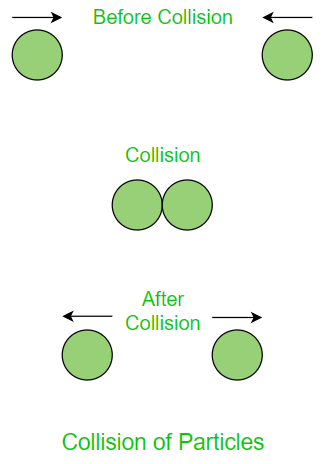粒子系统的线性动量
项目的质量 (m) 和速度 (v) 用于计算线性动量。停止具有更大动力的项目更加困难。 p = mv 是线性动量的公式。动量守恒是指动量的总量永远不会改变的事实。让我们更多地了解线性动量和动量守恒。
粒子系统的线性动量
我们知道粒子的线性动量为:
p = mv
其中 p 代表粒子的动量。
对于单个粒子,牛顿第二定律是:
F = dP / dt,
其中 F 代表粒子的力。
“n”个粒子的总线性动量为:
P = p 1 + p 2 + ...。 + p n
每个动量表示为 m 1 v 1 + m 2 v 2 +…………..+m n v n 。
质心的速度表示为:
V = ∑ m i v i ⁄ M
MV = ∑ m i v i
所以,当我们比较这些方程时,我们得到:
P = MV
As a result, we may state that, a system of particles’ total linear momentum is equal to the product of the system’s total mass and the velocity of its Centre of mass.
对上式微分:
dP ⁄ dt = M dV ⁄ dt
dV ⁄ dt 是质心的加速度。
假设 A 是质心的加速度。
因此, dP ⁄ dt = MA
MA 是外力,所以, dP ⁄ dt = F ext
这个方程只是应用于粒子系统的牛顿第二定律。如果作用在系统上的总外力为零,则称系统处于平衡状态。
如果 F ext = 0,则 dP ⁄ dt = 0。
P = 常数,因此。
When the entire force exerted on a particle’s system is equal to zero, the system’s total linear momentum is constant or conserved. This is the law of total linear momentum conservation for a system of particles.
如果没有外力,单个粒子的动量可能会波动,但它们的总和保持不变。术语“动量”是指向量。

两个粒子系统的动量守恒
粒子系统的总线性动量守恒
考虑放射性衰变的情况。放射性衰变的定义是什么?这是一个不稳定的原子核分裂成两个相对稳定的原子核的过程,在这个过程中释放出大量的能量。如果母核不稳定并希望变得稳定,它将发射一个粒子和另一个子核以实现稳定。与母核相比,这个子核明显更稳定。这是放射性衰变的定义。假设母核处于静止状态,子核的质量为 m,子核的质量为 M。
因此,母核的质量将是 m + M。在这种情况下发生的一切都是由于内力而不是外力。如果 F ext = 0,我们可以得出 dP ⁄ dt = 0 的结论。
因此, P = 常数。
If a body’s net external force is zero, the rate of change of momentum is likewise zero, implying that there is no change in momentum.
线性动量守恒示例
在速度 v 和 V 的情况下,两个质量为 m 和 M 的物体沿相反的方向行进。如果它们在撞击后碰撞并一起移动,我们必须确定系统的速度。
动量守恒,因为没有外力作用在两个物体的系统上。
Initial momentum = Final momentum
M V – m v = (M + m) vfinal
我们可以使用这个方程简单地计算系统的最终速度。
线性动量守恒应用
- 火箭的发射是动量守恒的应用之一。当火箭燃料燃烧时,废气被迫向下,因此火箭被推得更高。
- 摩托艇在同一场所运行;它们将水向后推并向前推动以保持推进力。
- 考虑运动第三定律,它描述了一个充气气球的运动。气球一放出,空气就从气球中逸出,它有动量。气球以与冲出的空气相反的方向移动以保存动量。
示例问题
问题1:两个质量相同的球以3 秒的间隔沿同一垂直线向上抛掷,初速度相同,为44.1 ms -1 。求每个球的总飞行时间,如果它们在某个高度碰撞,并且碰撞是完全无弹性的。
解决方案:
Given:
Initial velocity, u = 44.1 m s−1
Time interval between flights of two balls = 3 s
When the particles collide the height of both particles will be same,
For first particle, time will be ‘t’ and for second particle time will be (t – 3).
h = u t − (1 ⁄ 2) g t2 = u (t − 3) − (1 ⁄ 2) g (t − 3)2
u t − (1 ⁄ 2) g t2 = u t − 3 u − (1 ⁄ 2) g (t2 − 6 t + 9)
0 = − 3 u + 3 g t − (9 ⁄ 2) g
t = (u ⁄ g) + (3 ⁄ 2)
t = (44.1 ⁄ 9.8) s + 1.5 s = 6 s
By solving the quadratic equation in t we get the time of first collision to be 6 s.
h = 44.1 × 6 − (1 ⁄ 2) × 9.8 × 62
= 264.6 m − 176.4 m
= 88.2 m
Now by momentum conservation, velocity of particles after collision:
m (u − g t) + m (u − g (t − 3)) = (m + m) v′
m u − 6 m g + m u − 3 m g = 2 m v′
v′ = u − (9 ⁄ 2) g
= 0 m ⁄ s
Acceleration, a = − g
Now, assume time taken for collision with ground be t1
h = (1 ⁄ 2) g t12
t1 = √(2 h ⁄ g)
= √(2 × 88.2 ⁄ 9.8) s
= √18 s
Hence, total time of flights is (6 + √18) s and (3 + √18) s.
问题 2:给出很少的线性动量守恒定律的实际应用?
解决方案:
Few applications of conservation of linear momentum is listed below:
- By blowing air out of its mouth or tossing an object in the opposite direction of the direction in which he wishes to go, the person remaining on the frictionless surface can get away from it.
- When a guy leaps from a boat on the beach, the boat is pushed away from the coast somewhat.
- The recoil of a rifle.
问题 3:压缩弹簧将两个不相等的重量结合在一起。当绳子被火柴棒烧掉时,弹簧被释放,两个飞散的物体的数量是多少?
解决方案:
Two unequal masses are first joined by a compressed spring. The cord is then burned with a matchstick, and the spring is released, causing the two masses to separate and acquire velocities that are inversely proportional to their masses, resulting in equal momentum.
问题 4:考虑两个滑冰者,他们从休息开始,然后在冰上以减小的摩擦力相互推开。女人重45公斤,而男人重60公斤。女人正以 4 m ⁄ s 的速度离开。人的反冲速度是多少?
解决方案:
Given:
Mass of woman, m = 45 kg
Mass of man, M = 60 kg
Initial velocity = 0
Final speed of woman, v = 3.5 m ⁄ s
According to law of conservation of momentum,
0 = (45 × 4 + 60 V) kg m ⁄ s
V = – 3 m ⁄ s
The negative sign shows that the man will move in opposite direction to the woman.
Hence, the man’s recoil velocity is 3 m ⁄ s.
问题5:系统动量守恒的条件是什么?
解决方案:
If a body’s net external force is zero, the rate of change of momentum is likewise zero, implying that there is no change in momentum.
If Fext = 0, we may conclude that dP ⁄ dt = 0. So, P = constant.